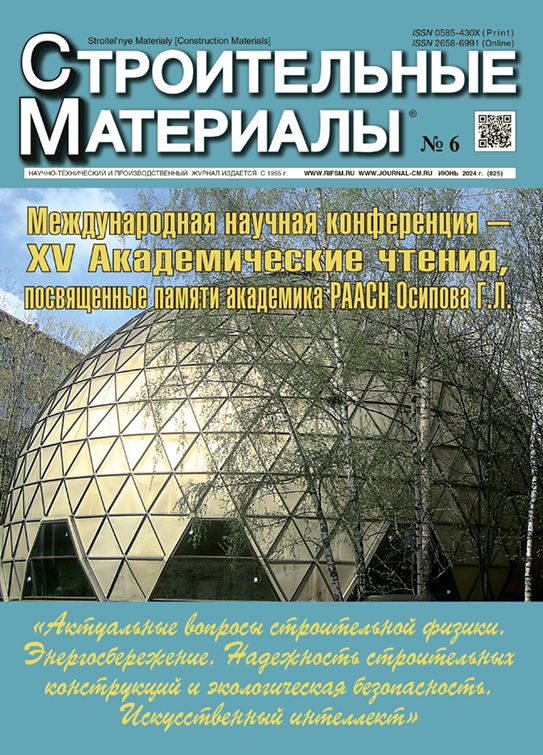Application of the Moisture Potential Theory in Assessing the Heat and Moisture Regime of Building Envelopes
- Authors: Zubarev K.P.1,2,3
-
Affiliations:
- National Research Moscow State University of Civil Engineering
- Scientific-Research Institute of Building Physics of RAACS
- RUDN University
- Issue: No 6 (2024)
- Pages: 46-51
- Section: International Scientific Conference – XV Academic readings dedicated to the memory of Academician of RAACS Osipov G.L., "Actual problems of building physics. Energy saving. Reliability of building structures and environmental safety. Artificial Intelligence"
- URL: https://freezetech.ru/0585-430X/article/view/635095
- DOI: https://doi.org/10.31659/0585-430X-2024-825-6-46-51
- ID: 635095
Cite item
Abstract
The review of existing mathematical models for humidity conditions was carried out. Methods giving an opportunity to calculate moisture transfer in the sorption zone of humidification and in the supersorption zone are described. The features of calculating moisture distribution using the theory of moisture potential are shown. The new discrete-continuous method for calculating the moisture state of a fence is proposed, which makes it possible to determine the unsteady-state moisture regime using an analytical expression without using various numerical methods. Two formulas for a single-layer and a multi-layer building envelope are derived. The formula allows us to determine the distribution of moisture potential in various sections of building envelopes. The effectiveness of the method is proven by comparing the results obtained with calculations using non-stationary and engineering quasi-stationary calculation methods. The humidity regime of a single-layer enclosing structure in the city of Moscow made of aerated concrete blocks, as well as a two-layer enclosing structure with a clay brick base and silicate brick cladding was calculated. It is shown that the calculation results using the proposed method are both quantitatively and qualitatively close to the distribution obtained using the non-stationary calculation method for both single-layer and multi-layer enclosing structures. The method is recommended for use in engineering work, because it gives a possibility to take into account the inertia of moisture in the building envelope.
Full Text
About the authors
K. P. Zubarev
National Research Moscow State University of Civil Engineering; Scientific-Research Institute of Building Physics of RAACS; RUDN University
Author for correspondence.
Email: zubarevkirill93@mail.ru
Candidate of Sciences (Engineering)
Russian Federation, Moscow; Moscow; MoscowReferences
- Vavrovic B. Importance of envelope construction renewal in panel apartment buildings in terms of basic thermal properties. Advanced Materials Research. 2014. Vol. 855, pp. 97–101. https://doi.org/10.4028/www.scientific.net/AMR.855.97
- Machinskij V.D. On condensation of air vapors in construction fences. Stroitel’naya promyshlennost’. 1927. No. 1, pp. 60–62. (In Russian).
- Fokin K.F. Stroitel’naya teplotekhnika ograzhdayushchih chastej zdanij [Construction the heating engineer of the protecting parts of buildings. Under the editorship of Tabunshchikov Yu.A., Gagarin V.G.]. Moscow: AVOK-PRESS. 2006. 256 p.
- Lukyanov V.I., Hlevchuk V.R., Gagarin V.G., Mogutov V.A. Rukovodstvo po raschetu vlazhnostnogo rezhima ograzhdayushchih konstrukcij zdanij [Guidelines for calculating the moisture conditions of building envelopes]. Stroyizdat, 1984. 168 p.
- Gagarin V.G. The theory of the state and the transfer of moisture in building materials and thermal insulation properties of building envelopes. Doctor Diss. (Engineering) Moscow. 2000. 396 p. (In Russian)
- Luk’yanov V.I. Non-stationary mass transfer in building materials and structures when solving the problem of increasing the protective qualities of building envelopes with damp and wet conditions. Doctor Diss. (Engineering). Moscow. 1994. 456 p. (In Russian).
- Galbraith G.H., Guo J.S., McLean R.C. The effect of temperature on the moisture permeability of building materials. Building research and infor- mation. 2000. Vol. 28. No. 4, pp. 245–259. DOI: https://doi.org/10.1080/09613210050073706
- Bogoslovskiy V.N. Osnovy teorii potenciala vlazhnosti materiala primenitel’no k naruzhnym ograzhdeniyam obolochki zdanij [Fundamentals of material potential moisture theory used in wall structures]. Moscow: MGSU. 2013. 112 p. (In Russian).
- Lykov A.V. Teoreticheskie osnovy stroitel’noj teplofiziki [Theoretical foundations of building thermophysics] Minsk. 1961. 520 p. (In Russian).
- Perekhozhencev A.G. Study of moisture transfer processes in porous building materials when solving problems of predicting the humidity state of heterogeneous building envelopes. Doctor Diss. (Engineering). Moscow. 1998. 323 p. (In Russian).
- Künzel H.M. Simultaneous heat and moisture and moisture transport in building components. Simultaneous heat and moisture and moisture transport in building components. PhD Thesis, Fraunhofer Institute Building Physics, Germany. 1995. 102 p.
- Arfvidsson J., Claesson J. Isothermal moisture flow in building materials: modelling, measurements and calculations based on Kirchhoff’s potential. Building and environment. 2000. Vol. 35. Iss. 6, pp. 519–536. https://doi.org/10.1016/S0360-1323(99)00045-1
- Kozlov V.V. Engineering assessment of moisture condition of modern wall structures with increased heat-insulating level accounting for vapor permeability, moisture conductivity and air filtration. Doctor Diss. (Engineering) Moscow. 2004. 155 p. (In Russian)
- Zolotov A.B., Mozgaleva M.L., Akimov P.A., Sido- rov V.N. About one discrete-continual method of solution of one-dimensional heat conductivity problem. Academia. Arhitektura i Stroitel’stvo. 2010. No. 3, pp. 287–291. (In Russian)
- Gagarin V.G., Akhmetov V.K., Zubarev K.P. Moisture behavior calculation of single-layer enclosing structure by means of discrete-continuous method. MATEC Web Conf. International Science Conference SPbWOSCE-2017 “Business Technologies for Sustainable Urban Development”. 2018. Vol. 170. https://doi.org/10.1051/matecconf/201817003014
Supplementary files










